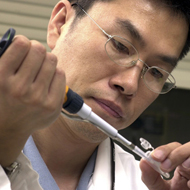
Environmental Factor, January 2008, National Institute of Environmental Health Sciences
Superfund Basic Research Program Anniversary
By Eddy Ball
January 2008
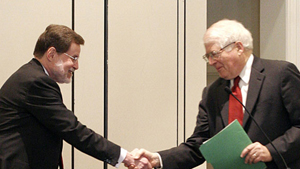
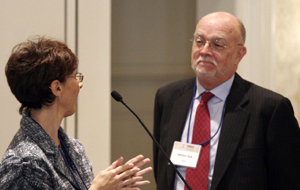
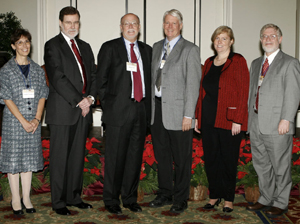

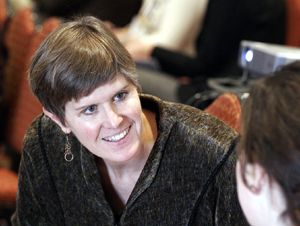
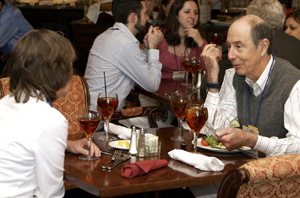
For pioneers in the NIEHS Superfund Basic Research Program (SBRP)(http://www.niehs.nih.gov/research/supported/sbrp/index.cfm), the twenty year anniversary celebration December 1-3 was a time to acknowledge the program’s many laurels — and look forward to new challenges. Grantees, students, administrators and friends of SBRP gathered on the Duke University Campus at the Washington Duke Inn for a full agenda of partnership reaffirmation, presentations by outstanding researchers, poster sessions, science sessions and a colloquium on the program’s visions for the future (see related Science Notebook story), chaired by SBRP Acting Director Claudia Thompson, Ph.D.
Aptly titled “20 Years of Success and a Vision for the Future,” the event drew more than 350 attendees, one-third of them postdoctoral fellows and students. SBRP was authorized by Congress in 1986 at a time when images of the fiery Cuyahoga River and the Love Canal disaster still resonated in the American consciousness, and it officially began operations in 1987 — administering a network of university grants designed to seek solutions to the complex health and environmental issues associated with the nation's hazardous waste sites.
One of the program’s most loyal supporters in Washington since his first term began in 1987, North Carolina’s Fourth District Representative David Price, Ph.D., joined NIEHS Acting Director Sam Wilson, M.D., in opening remarks underscoring the enormous contributions of SBRP to the nation’s environmental health.
Wilson and Price both described the program as the “crown jewel” of environmental programs. “There aren’t any programs that achieve what the Superfund Basic Research Program achieves… [from] on-the-ground impact on human health to fundamental production of knowledge,” Wilson observed. In his remarks, Price called SBRP “one of our most productive federal research programs” and underscored the relevance of SBRP research to the country’s efforts to ensure homeland security.
Present at the meeting were several NIEHS people who were involved in the program from the beginning, including Acting Deputy Director Bill Suk, Ph.D., who was SBRP’s first director. He was joined by Chip Hughes, the program director who established the SBRP Worker Education Training Program, and Anne Sassaman, Ph.D., director emeritus of the Division of Extramural Research and Training, which oversees the program’s administrative staff.
Throughout the meeting’s sessions, the program emphasized several major themes of SBRP:
Partnerships: SBRP fosters partnerships among research institutions, the public and private sectors and agencies with interests in Superfund sites. At the meeting, Partnerships Session speakers included Susan Bodine, J.D., assistant administrator of the U. S. Environmental Protection Agency Office of Solid Waste and Emergency Response, and Henry Falk, M.D., director of the Centers for Disease Control and Prevention Center for Environmental Health.
“Trans-Disciplinary” Approaches: Suk suggested replacing the term “interdisciplinary” with “trans-disciplinary” as a more accurate description of the kind of collaborative research that SBRP encourages. SBRP investigations do more than cross the divisions between disciplines in an area of science; they routinely bridge the even greater chasms between realms of science, such as those separating the pursuit of knowledge in the biological, geo-physical, ecological, engineering and social sciences.
Nurturing the Next Generation: The 120 postdoctoral fellows and graduate students in attendance were a major presence at the event. There were special student events, such as the pre-meeting social and student mixer, poster sessions and receptions and meals that encouraged interaction among students, grant administrators and SBRP center directors. Student presentations constituted 40 to 60 percent of the four science sessions, and among the meeting highlights was the presentation of student awards (see Extramural Update (http://www.niehs.nih.gov/news/newsletter/extramuralupdate.cfm)).
The SBRP pioneers deserve to look back on the past 20 years with pride. In the two decades of SBRP, the program has supported researchers who have published more than 8,290 papers, received more than 65 patents on methods and technology, pioneered new assessment methodologies, contributed to mediation at more than 200 sites and trained hazardous material first responders nationwide.
Just as importantly, it has laid the foundation for the research teams that will carry on the good work in the decades to come.
Poet-Scientist Sandra Steingraber on “Living Downstream”
Born in 1959 in Peoria, Ill., biologist Sandra Steingraber, Ph.D., grew up on the banks of the Illinois, down stream from Rockford, Ill., a hazardous waste site located atop an aquifer. She is a survivor of bladder cancer, which she described as “the quintessential environmental cancer,” as well as the adopted child of a mother who has survived breast and bone cancer and a father who developed Lewy Body Dementia when Steingraber was still a teenager. In her keynote presentation at the SBRP anniversary meeting, she explained that she learned the hard way that “families have a lot more than genes in common” and, as a woman who became pregnant in her late thirties, that “I am a habitat” for my unborn child.
Steingraber, who is now a Distinguished Visiting Scholar at Ithaca College in upstate New York, holds a master’s degree in English literature and a doctorate in biology. She has combined her two loves — of the word and the human organism — into an ecological crusade for bottom-up public advocacy. She is on a mission to combat what she terms “the cultural amnesia about Superfund” and describes herself as a “cancer abolitionist.” By emphasizing that “every data point is a human life,” Steingraber is out to stem “sin by silence” with a challenge to the very concept of acceptable levels of contamination in environmental regulation.
Along with her books, Post Diagnosis, a poetry collection, Having Faith, an account of her pregnancy with her daughter, Faith, and Living Downstream: An Ecologist Looks at Cancer and the Environment, Steingraber works in the tradition of Rachael Carson to channel grass roots concerns into scientific investigation. With the support of the Breast Cancer Fund (http://www.breastcancerfund.org/) ![]() , she authored a reader-friendly review of research on breast cancer risk, The Falling Age of Puberty in U.S. Girls: What We Know, What We Need to Know, which is available free in hardcover and as a download (http://www.breastcancerfund.org/site/apps/nl/content3.asp?c=kwKXLdPaE&b=70693&ct=4367471)
, she authored a reader-friendly review of research on breast cancer risk, The Falling Age of Puberty in U.S. Girls: What We Know, What We Need to Know, which is available free in hardcover and as a download (http://www.breastcancerfund.org/site/apps/nl/content3.asp?c=kwKXLdPaE&b=70693&ct=4367471) ![]() .
.
![]() next story - "Leadership and Gender..."
next story - "Leadership and Gender..."
January 2008 Cover Page
